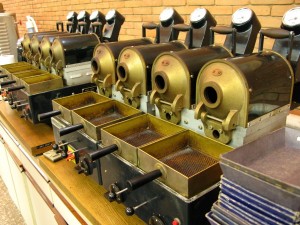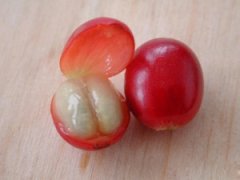Experience in roasting raw beans of Panamanian coffee
The Panamanian beans at Brista Coffee West Point training School are very different from Essel beans. The particles are large and thick. It is not easy to be heated evenly, and experienced bakers will find that these beans are so nutritious that they are like superhuman beans raised by milk. If it heats up too fast, it will burn the beans. Resulting in half-cooked. If it's slow, it will make it smell like dry bread. Although Bristol Coffee West Point training school has a good taste of beans, many baking mistakes will retain a lot of good features. But are you willing to do it?
Panamanian coffee beans in roasting to reach 1 burst dense out of beans, can be shallow, but not over 1 burst.
Here's a baking curve to avoid some expensive mistakes:
Let's start with 1 explosion and 2 explosion.
After 1 explosion, it means that no more "bang" sound can be heard after the explosion.
Many people have also asked about the difference between the first explosion and the second explosion. We found that one thing to pay attention to is to achieve "dense": if the beans are baked unevenly, it is easy to blend into 2 bursts if the beans are not dense.
1 explosion is like a bullet to start, "explosion" after a few seconds, "explosion" after a few seconds, and then you will hear "explosion, explosion" this is not dense explosion. The sound of 1 burst is from scattered to dense, and then to scattered, and before it stops, it will be denser again, and the second time it will be hit by 2 explosions.
Brista Coffee West Point training School beans will lose a lot of its colorful flavor when they explode in 2. If you mix 1 and 2 explosions, part of your beans will be carbonized and some of them will still be developing. Such beans are easy to taste bitter when they are flushed by hand.
Is it possible that the explosion is not dense? That's for sure. If the beans are right and the baking is right, it must be possible. You happen to mix well-flavored shallow beans with deeper mellow beans, and the proportion is perfect. There will be good beans. But in practice, how many people can control the distribution of the beans? Can the uniformity be the same every time? In addition, even if the skilled baker answers yes. The next time this bean has a little more moisture due to environment, storage, processing or other reasons, its density has changed a little bit due to nutrition, and its distribution has changed a little bit-can you still guarantee it? Therefore, in order to stabilize the production, we advocate that it should be intensive first.

Important Notice :
前街咖啡 FrontStreet Coffee has moved to new addredd:
FrontStreet Coffee Address: 315,Donghua East Road,GuangZhou
Tel:020 38364473
- Prev

[90 + boutique coffee] lychee and cello LycelloW2
Lychee and cello (LycelloW2) [Origin]: 90 + Panamanian Rosa Manor [season]: 2013 to 2014 [Variety]: Rosa [Level]: 21 [altitude]: 1250m-1650m/ [treatment]: washing [Flavor]: on the basis of the flavor of the rose seed itself, it shows rich aromas of green tea, musk and basil herbs.
- Next

[90 + boutique coffee] Hatchilla HachiraN2
HachiraN2 [Origin]: 90 + Ethiopia Achira (Achilla) producing area. [season]: 2013-2014 [variety]: Ethiopian native species [Level]: 12 [altitude]: 17502000m [treatment]: sun [flavor]: full of floral smell, obvious sense of fruit juice, with the wind of elderberry, BlackBerry and basil herbs.
Related
- Guji coffee producing area of Guji, Ethiopia: Humbela, Shakiso, Wulaga
- What is the most expensive variety of Qiloso in BOP multi-variety group?
- How to store the coffee beans bought home?
- Why are Yemeni coffee beans so rare now?
- Ethiopian Sidamo all Red Fruit Sun Sun Santa Vini Coffee beans
- SOE is mostly sour? What does it mean? Is it a single bean? what's the difference between it and Italian blending?
- Is Italian coffee beans suitable for making hand-brewed coffee?
- How to choose coffee beans when making cold coffee? What kind of coffee beans are suitable for making cold coffee?
- Just entered the pit to make coffee, what kind of coffee beans should be chosen?
- Can only Japan buy real Blue Mountain Coffee? What are authentic Jamaican Blue Mountain coffee beans?

